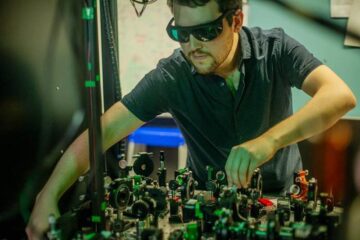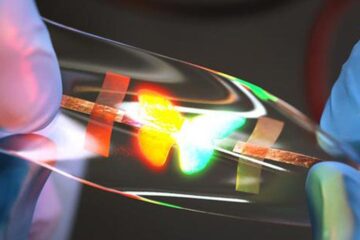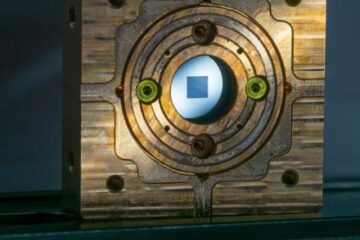Wildlife researchers identify impacts of contamination in amphibians

Bill Hopkins, fisheries and wildlife associate professor in Virginia Tech’s College of Natural Resources, and colleagues doing research at the Savannah River Ecology Laboratory and in the field, have demonstrated that amphibians are exposed to contaminants through maternal transfer, as has been proven for other vertebrates.
The research has been published in the National Institutes of Health (NIH) journal, Environmental Health Perspectives (“Reproduction, Embryonic Development, and Maternal Transfer of Contaminants in the Amphibian Gastrophryne carolinensis,” by William Alexander Hopkins, Sarah DuRant, a fisheries and wildlife graduate student at Virginia Tech; Brandon Staub, a research technician with the University of Georgia; Christopher Rowe, an environmental toxicologist with the Chesapeake Biological Laboratory, University of Maryland; and Brian Jackson, an analytical chemist at Dartmouth College.)
While working as an assistant professor and research scientist with the Savannah River Ecology Laboratory in Aiken, S.C., Hopkins and colleagues collected dozens of reproductively active female eastern narrow mouth toads located around a settling basin near a coal burning power plant outside of Aiken.
The burning of coal is responsible for the release of mercury, selenium, and other harmful contaminants into the environment. The research team tested the toads and their offspring for the presence of chemical contaminants, and their offspring were examined for developmental abnormalities such as structural malformations and abnormal swimming. “We also looked at clutch size (number of eggs), how many eggs successfully hatched, along with developmental characteristics such as pigmentation and spinal formation,” says Hopkins.
Both the adult females and their offspring from the power plant’s settling basin were compared to adults and their offspring from a reference site, which was free from contamination. The research identified particularly high levels of selenium in the offspring from the contaminated site. “Selenium is a fascinating trace element,” says Hopkins. “Although it is nutritionally required as a micronutrient, there’s a fine line between its essentiality and toxicity. We found that females from areas near the power plant accumulated astonishingly high concentrations of selenium in their tissues, and then transferred nearly equivalent concentrations of selenium to their young.”
The research team uncovered one of the primary means of exposure to environmental contaminants in amphibians. Female amphibians can transfer high levels of certain contaminants to their offspring, resulting in decreased offspring viability.
There have been numerous studies on the detrimental effects of selenium on fish and birds, as well as Hopkins’ study on alligators and lizards. Exposure to selenium is not always obviously harmful to fully-grown vertebrates, but is particularly disruptive to their reproduction function due to its propensity to transfer from mother to egg and its subsequent effects on the developing embryo.
Hopkins’ research is one of the first studies to demonstrate how amphibians are exposed to contaminants through maternal transfer, which is a proven means of exposure for other vertebrates such as fish, birds, humans, and other mammals. “Our study confirms that in amphibians, like all other vertebrate classes, this may be one of the most important means of exposure to some contaminants, such as selenium and polychlorinated biphenyls (PCBs),” says Hopkins. “The presence of reproductive abnormalities in animals that transfer contaminants to their eggs illustrates how maternal transfer is very ecologically relevant.”
Hopkins and his research team were successful in showing the effects of chemical contaminants through actual conditions in the field instead of using a lab environment to simulate potential contaminant exposure. “Generally, many amphibian studies on contaminant exposure take place exclusively in the lab or other experimental setting, where the subject is exposed to a controlled dose of contaminants. However, we were able to look at how these toads are more realistically impacted by contaminants in a natural habitat polluted by human activities,” Hopkins notes.
Media Contact
All latest news from the category: Ecology, The Environment and Conservation
This complex theme deals primarily with interactions between organisms and the environmental factors that impact them, but to a greater extent between individual inanimate environmental factors.
innovations-report offers informative reports and articles on topics such as climate protection, landscape conservation, ecological systems, wildlife and nature parks and ecosystem efficiency and balance.
Newest articles

Combatting disruptive ‘noise’ in quantum communication
In a significant milestone for quantum communication technology, an experiment has demonstrated how networks can be leveraged to combat disruptive ‘noise’ in quantum communications. The international effort led by researchers…

Stretchable quantum dot display
Intrinsically stretchable quantum dot-based light-emitting diodes achieved record-breaking performance. A team of South Korean scientists led by Professor KIM Dae-Hyeong of the Center for Nanoparticle Research within the Institute for…

Internet can achieve quantum speed with light saved as sound
Researchers at the University of Copenhagen’s Niels Bohr Institute have developed a new way to create quantum memory: A small drum can store data sent with light in its sonic…





















